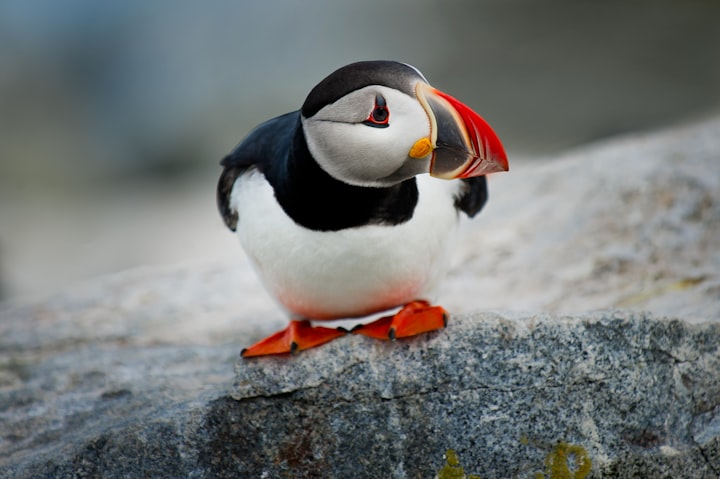
The Mysterious Tufted Puffin: An Illustration of Coastal Style and Avian Expertise
The tufted puffin, or Fratercula cirrhata as it is scientifically named, is a famous seabird that attracts the attention of both birdwatchers and onlookers along the shore. As a member of the auk family, this captivating bird is well-known for its unusual look, which consists of a flashy blend of vivid colors and eye-catching tufted plumes. In order to solve the mystery surrounding this coastal avian species, we will explore the lives, habitat, behavior, and conservation relevance of the tufted puffin.
Physical characteristics: The tufted puffin stands out from other seabirds thanks to a remarkable profile and a variety of traits. A plume of long, straw-colored feathers that extends backward from their eyes adorns adults, giving them a comical and endearing appearance. These tufts, which give their appearance an added touch of beauty, are especially noticeable during the breeding season. With a characteristic white face and black head, the remainder of their plumage is a mixture of black and white.
The huge bright bill of the tufted puffin is one of its most striking characteristics. The bill turns a vibrant orange color during the breeding season, which contrasts sharply with the bird's black and white plumage. The tufted puffin's principal food source is small fish, which may be efficiently caught and held by the bill's shape.
Habitat and Range: The North Pacific is home to puffed puffins, which have a range that stretches from Alaska's coast to northern California. They are attracted to coastal areas, like as sea cliffs and offshore islands, where they dig tunnels in rocky or grassy terrain to lay their eggs. The quantity of small fish and crustaceans found in these environments serves as vital prey for the puffin population.
Tufted puffin breeding colonies are located on islands, where the birds display their incredible aerial maneuvers while going on their daily foraging missions. They are well suited to the demanding and turbulent marine habitats they live in because of their capacity to travel great distances and dive for food.
Behavior and Diet: Using their wings to fly across the water for long distances, puffins are skilled and nimble aviators. Their swift wingbeats, frequently interspersed with glides barely above the water's surface, define their flight pattern. Tufted puffins appear awkward on land, yet they are remarkably skilled in the air.
Small fish like herring and sand lance, as well as invertebrates like squid and crustaceans, make up the majority of the tufted puffin's diet. These birds go on long foraging expeditions throughout the breeding season, returning to their nesting colonies with food safely stored in their bills. The tufted puffin's large beak makes it possible for it to catch and transport several small fish at once, which makes hunting more effective.
Tufted puffins develop breeding colonies over the summer and are very devoted to their nesting places. Males use their tufted plumes and multicolored bills in elaborate courtship displays to entice possible partners. Tufted puffins, once coupled, share parental duties; they alternately incubate the lone egg and then tend to the chick.
Conservation Status and dangers: Although tufted puffins are not currently listed as endangered worldwide, there are dangers to some local populations that need to be taken seriously. The main issues include habitat disruption, the effects of climate change on ocean conditions, and the reduction in prey availability brought on by over-fishing.
Tufted puffins are among the seabirds that are sensitive indicators of the condition of maritime ecosystems. Their populations may be affected in a cascade manner by shifts in the availability of prey or modifications to marine conditions. The long-term survival of tufted puffins and the ecosystems they live in depends on tracking and mitigating these risks.
The populations of tufted puffins are also at risk from human activities. Human disturbances, especially in the breeding season, might result in stressed out birds and abandoned nests. Protection initiatives involve keeping an eye on breeding colonies, creating protected areas, and putting policies in place to reduce interference from humans.
Beyond their ecological significance, tufted puffins are also culturally significant in many coastal communities. Their unique appearance and behaviors attract attention and serve as inspiration for local folklore, storytelling, and art, and their presence in coastal environments supports the biodiversity and general health of these ecosystems.
The tufted puffin's function in marine food webs highlights how species are interdependent within the ecosystem. Because they are piscivores, which eat small fish, they help to control the number of prey and preserve the equilibrium of marine ecosystems.





Comments
There are no comments for this story
Be the first to respond and start the conversation.